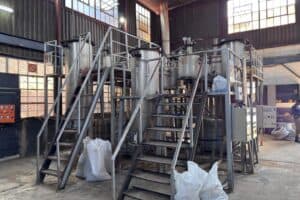According to the PwC report, Mine 2025: Concentrating on the Future, the global mining sector endured a challenging year in 2024.

The global mining sector fell by 3% last year according to a new report, although gold earnings increased 32%.
It says high costs and increasing investment are eating into the top 40 global mining companies’ profits, but strategic opportunities are emerging.
According to the report, the top 40 performers, excluding gold-focused firms, saw revenues fall by 3% and earnings before interest, taxes, depreciation and amortisation decrease by 10%.
However, while most of the industry battled increasing costs and tightening margins, record gold prices meant that gold revenues increased by 15%, while gold earnings before interest, taxes, depreciation and amortisation (EBITDA) rose 32% as a result of operating leverage.
The increasing costs and narrowing margins placed pressure on much of the industry, pushing overall EBITDA margins down to 22%, compared to 24% in 2023.
ALSO READ: SA’s shrinking mining sector and the policies that brought us here
Report’s focus on global mining sector
Andries Rossouw, energy, utilities and resources leader at PwC Africa, says the report focuses on the role mining plays in expanding and interlocking domains of human activity. “We examine the ways that value is put into motion, as megatrends – and the responses to them – dictate developments in supply, demand and investment.
“We also examine how the domains of growth identified in our Value in Motion thought leadership are creating opportunities for the mining industry.”
He points out that concentration risk arises from the natural endowment of mineral resources that cannot be changed and the enabling environments created by countries. As a result, over the years, he says, there was an increase in the concentration of both reserves and production, as well as the development of substantial mismatches between the two.
“The concentration of mining and processing in a small number of geographies creates the risk that global supply and prices will be affected by location-specific challenges, such as natural disasters, wars, social unrest, political or regulatory changes and infrastructure failures.
“Countries adopted various strategies to secure supply and leverage the value of key commodities. Megatrends are transforming the industry, driving the need for new supply chains, influencing national strategies, fostering innovative collaborations and unlocking new value pools.”
ALSO READ: Mining fails to deliver jobs to local communities
Demand for mixed mining resources continues to grow
Rossouw says as the world undergoes rapid urbanisation, transitions to new energy sources and embraces technological advancements, the demand for mined resources continues to grow. “These global forces are reshaping industries, making mining central to how we move, build, feed, care and power society.”
If mining companies are to create value for stakeholders in the emerging world of domains, they must future-proof their businesses, he says. “The growth of these domains also offers potential for mining companies to become involved in other industries that help mines operate more effectively.
“These efforts often result in economic development initiatives that provide benefits to the climate as well as broader society. Beyond the domains of growth, key trends such as population growth, the energy transition, environmental impact, tech innovation and AI, and access to funds as well as policy and regulation are expected to shape the future of the industry.
“However, as we forge ahead, one thing is certain: collaboration will be essential in 2025, in 2030 and in 2035.”






